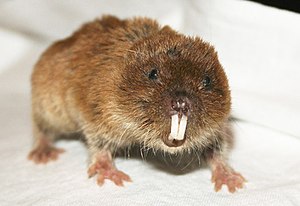Mull lemmings
| Mull lemmings | ||||||||||||
|---|---|---|---|---|---|---|---|---|---|---|---|---|

Northern Mull Lemming |
||||||||||||
| Systematics | ||||||||||||
|
||||||||||||
| Scientific name | ||||||||||||
| Ellobius | ||||||||||||
| Fischer von Waldheim , 1814 |
The mulled lemmings ( Ellobius ) are a genus of voles that is common in western and central Asia. Despite their name, they are not lemmings , but outwardly they look similar. Unlike lemmings, they lead a completely subterranean way of life.
A distinction is made between five types. These are divided into two sub-genera, which are sometimes also viewed as separate genera:
- Subgenus Ellobius
- Northern mulled lemming , Ellobius talpinus , from eastern Ukraine to Kazakhstan to northern Afghanistan
- Zaisan Mull Lemming , Ellobius tancrei , Turkmenistan , Uzbekistan , Kazakhstan, Xinjiang
- Alai Mull Lemming , Ellobius alaicus , Alai Mountains
- Subgenus Afganomys
- Transcaucasian Mulled Lemming , Ellobius lutescens , Caucasus , Anatolia , Iraq
- Southern Mulled Lemming , Ellobius fuscocapillus , Iran , Afghanistan, Turkmenistan, Pakistan
Mulled lemmings are cylindrical in shape. Their head body length is 10 to 15 cm, the tail is stubby and only 5 mm to 2 cm long. The fur is brown or gray on top and gray or white on the underside. External ears are absent and the eyes are greatly reduced in size and almost hidden under the fur. The enlarged incisors that protrude forward from the mouth are noticeable. They are used when digging.
The tunnels of the Mulled Lemmings run about 20 to 30 cm below the ground. They form a widely branched system, part of which is a nest chamber at a depth of 50 cm. When digging, they look for underground parts of plants, i.e. roots and tubers, which are their food. In some regions, they are therefore considered agricultural pests.
Most of the time, Mulled Lemmings are assigned to their own tribe Ellobiini within the voles. However, this is not guaranteed. Some zoologists have completely removed the gauze lemmings from the voles and classified them as "Muridae incertae sedis " (long-tailed mice with an uncertain systematic classification). Most authorities, however, see voles in Mull-Lemmingen, albeit deviating and highly specialized representatives. In the Pleistocene , the genus was more widespread and also native to Palestine and North Africa.
literature
- Ronald M. Nowak: Walker's Mammals of the World. 2 volumes. 6th edition. Johns Hopkins University Press, Baltimore MD et al. 1999, ISBN 0-8018-5789-9 .